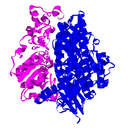en
names in breadcrumbs


Desulfovibrio is a genus of Gram-negative sulfate-reducing bacteria. Desulfovibrio species are commonly found in aquatic environments with high levels of organic material, as well as in water-logged soils, and form major community members of extreme oligotrophic habitats such as deep granitic fractured rock aquifers.
High amounts of Desulfovibrio bacteria have been associated with inflammatory bowel disease, bacteremia infections and Parkinson's disease.[1][2]
Some Desulfovibrio species have in recent years been shown to have bioremediation potential for toxic radionuclides such as uranium by a reductive bioaccumulation process, such as converting highly water-soluble U(VI) to relatively insoluble U(IV) precipitate, thus removing the toxic uranium from contaminated water.[3]
The currently accepted taxonomy is based on the List of Prokaryotic names with Standing in Nomenclature (LPSN)[4] and National Center for Biotechnology Information (NCBI)[5]
Unassigned species:
{{cite journal}}: CS1 maint: multiple names: authors list (link) {{cite journal}}: CS1 maint: multiple names: authors list (link) Desulfovibrio is a genus of Gram-negative sulfate-reducing bacteria. Desulfovibrio species are commonly found in aquatic environments with high levels of organic material, as well as in water-logged soils, and form major community members of extreme oligotrophic habitats such as deep granitic fractured rock aquifers.
High amounts of Desulfovibrio bacteria have been associated with inflammatory bowel disease, bacteremia infections and Parkinson's disease.
Some Desulfovibrio species have in recent years been shown to have bioremediation potential for toxic radionuclides such as uranium by a reductive bioaccumulation process, such as converting highly water-soluble U(VI) to relatively insoluble U(IV) precipitate, thus removing the toxic uranium from contaminated water.